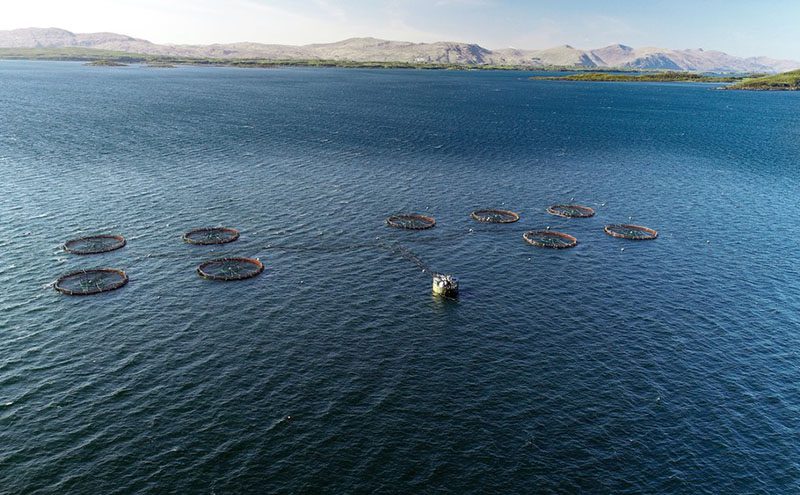
Scottish salmon farm medicine is significantly impacting local marine environments, concludes one of Scotland’s largest and most comprehensive marine research projects into aquaculture, undertaken by the Scottish Environment Protection Agency, with results released on 7 November.
The survey, ‘Fish Farm Survey Report – Evaluation of a New Seabed Monitoring Approach to Investigate the Impacts of Marine Cage Fish Farms’, undertaken by specialist marine scientists using research vessel the Sir John Murray, examined environmental impacts from eight Scottish fish farms. 302 chemical samples were analysed from 93 sample stations and 296 ecological samples from 142 sample stations.
Samples for chemical analysis were analysed for the sea lice medicine Emamectin Benzoate (EmBz) and Teflubenzuron (Tef), last used in 2013. The medicines were detected in 98% and 46% of samples respectively, with residues more widely spread in the environment around fish farms than had previously been found. Moreover, the research concluded that the impacts of individual farms may not be contained to the vicinity of individual farms.
The research survey was published today (Wednesday, 7th November) as part of proposals by SEPA, one of a number of organisations regulating finfish aquaculture*, for a revised regime that will strengthen SEPA’s regulation of the sector. The proposals follow 16 months of work by the agency, including a 2017 consultation, and two Scottish Parliamentary committees, one of which concluded that “the status quo is not an option”, adding that the industry’s expansion goal “will be unsustainable and may cause irrecoverable damage to the environment” unless governance and practices are improved markedly.
Scotland is the largest Atlantic salmon aquaculture producer in the European Union and third in the world after Norway and Chile. A contributing factor to this is Scotland’s reputation for a high quality environment and abundant freshwater resources.
SEPA’s says its draft Finfish Aquaculture Sector Plan is ambitious in its aspirations for an industry where in the future:
- The Scottish finfish aquaculture sector recognises that protecting the environment is fundamental to its success and is foremost in all its plans and operations.
- The sector is a world-leading innovator of ways to minimise the environmental footprint of food production and supply.
- The sector has a strong and positive relationship with neighbouring users of the environment and the communities in which it operates. It is valued nationally for its contribution to achieving global food security.
It is also clear that all operators in the sector will reach and maintain full compliance with Scotland’s environmental protection laws, with SEPA working to help as many operators as possible to move beyond compliance.
Whilst SEPA’s latest Compliance Assessment Scheme (CAS) data saw overall compliance levels for the sector drop during 2017 to 81.14%, against a relative peak of 85.75% in 2016, the industry is innovating through the use of ‘non medicinal farming’ using wrasse, a small fish that tackles sea lice, full or partial containment and enhanced fallowing.
SEPA has put forward a set of firm, evidence based proposals for a revised regime that will strengthen the regulation of the sector. These include:
A NEW TIGHTER STANDARD FOR THE ORGANIC WASTE DEPOSITED BY FISH FARMS
Marine cage fish farming across Scotland operates using open-net cages. Fish faeces; any uneaten food; used fish medicines and other chemical treatments escape from these cages into the marine environment. The heavier, organic particles (the fish faeces and uneaten food) together with any medicines sticking to them are deposited on the sea floor. Natural biological process then break down and assimilate the material over time.
The tighter standard limits the spatial extent of the mixing zone around farms. The controls we will apply to these mixing zones will bring them into equivalence with modern practice on mixing zones for other waste effluent discharges into the sea, including those from urban waste water.
MORE POWERFUL MODELLING USING THE BEST AVAILABLE SCIENCE
The new regulatory framework will use new, more accurate computer modelling approaches that will improve our understanding of the risk to the local environment and allow assessment of the larger-scale impacts including interactions with other farms.
The science about fish farming is very complex and these new approaches will bring the aquaculture sector up to date with the modelling practices which are being used for other industrial sectors where there is a longer history of operation and analysis.
ENHANCED ENVIRONMENTAL MONITORING & NEW ENFORCEMENT UNIT
Operators will be required to invest in more accurate monitoring, including of waste coming from fish farms. The creation of a new enforcement unit will strengthen the checking and verifying of monitoring that fish farm operators are required to undertake. SEPA will also increase and strengthen monitoring of the impact of fish farms in surrounding areas.
NEW INTERIM APPROACH FOR CONTROLLING THE USE OF EMAMECTIN BENZOATE
SEPA has asked the UK Technical Advisory Group (UK TAG), a partnership of the UK environment and conservation agencies, to make recommendations on new environmental standards for Emamectin Benzoate to the Scottish Government. UK TAG was established by the governments of the different parts of the UK to oversee the scientific process of developing the environmental standards used across the UK for protecting the water environment.
UK TAG is in the process of developing its recommendations. This includes obtaining and considering independent scientific peer reviews of the evidence. After UK TAG makes its recommendations to the Scottish Government, Scottish Government will consult on draft directions on the establishment of new environmental standards.
While this UK TAG work continues, SEPA will adopt a precautionary principle position which imposes a much tighter interim standard for the use of Emamectin Benzoate at any new site. This is based on the now substantial weight of scientific evidence that the existing standards do not adequately protect marine life. This interim standard will set a limit so low that it will, effectively, mean Emamectin Benzoate can only be discharged in very limited quantities at any new site.
NEW APPROACH TO SUSTAINABLE SITING OF FARMS
The combination of the new standard, the more accurate model and enhanced monitoring will allow the siting of farms in the most appropriate areas where the environment can assimilate wastes. It will also allow SEPA to better match biomass to the capacity available in the environment and continue to assess that through the operation of the site. This may allow for the approval of larger farms than would have been traditionally approved previously, provided they are appropriately sited in sustainable locations.
Overall, the proposals will combine to encourage operators to site and operate their fish farms in environmentally less sensitive waters and use improved practices and technologies to reduce environmental impact.
In practice, we anticipate this will lead to fewer fish farms in shallower, slow-flowing waters and more fish farms in deeper and faster-flowing waters. We also anticipate it will encourage the adoption of new technologies such as partial and full containment to capture organic waste and any remaining medical residues. SEPA has seen some industry operators successfully developing new approaches such as non-chemical ways of managing fish health. Our new regime will support these encouraging developments.
As one of a number of organisations regulating finfish aquaculture, SEPA believes its proposals have the potential to significantly improve in the environmental performance of the industry.
Recognising the diverse range of views of finfish aquaculture, SEPA is keen to hear directly from individuals, interest groups, NGOs, communities, companies and others with a view on the regulatory proposals.
As part of a seven-week public consultation, SEPA will embark on one of its most significant public engagement programmes to date. SEPA will host a series of nine events across Scotland during November and December where people can find out more, talk directly with specialist teams and provide direct feedback as we strengthen our regulatory approach.
Terry A’Hearn, Chief Executive of the Scottish Environment Protection Agency, said:
“Whilst a high quality environment and abundant freshwater resources are vital to Scotland’s aquaculture sector, it’s an industry that attracts polarised positions, from those who cite its economic contribution to those who stridently oppose its existence.
“As one of a number of organisations regulating finfish aquaculture, SEPA is clear that our job is to make sure environmental standards protect the marine environment for the people of Scotland and we make sure the industry meets those. That’s unequivocally our focus.
“Consequently across the last sixteen months we’ve done more science, more analysis and more listening than ever before. Whilst we’re seeing innovation in the sector, we’ve concluded that Scottish salmon farm medicine is significantly impacting local marine environments which increases the now substantial weight of scientific evidence that the existing approaches do not adequately protect marine life.
“We agree that ‘the status quo is not an option’ which is why we’re announcing firm, evidence based proposals for a revised regime that will strengthen the regulation of the sector. As part of a Scotland-wide consultation, we’re now keen to hear directly from individuals, interest groups, NGOs, communities, companies and others on their views on the proposals as we move to strengthen our regulatory approach.”






